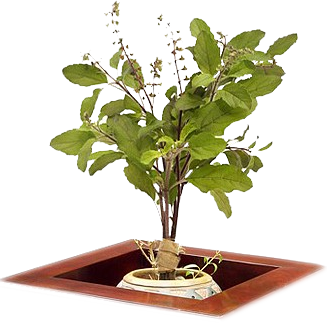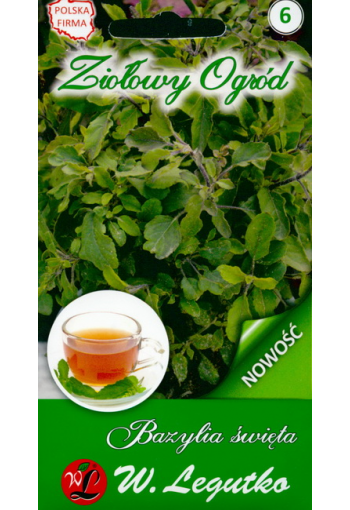Perennial herb or shrub of the Lamiaceae family. A medicinal plant with unique properties - the most revered in India after the lotus. Holy Basil is ideal for growing as an indoor perennial or as an annual outdoors. Plant height 30-40 cm.
Holy basil leaves improve overall health, remove toxins from the body, and are used in the treatment of colds, flu and asthma. The leaves are small, with jagged edges, covered with thin villi, up to 5 cm long. After the formation of 4-6 leaves, the tops must be pinched. With a bush height of 12-15 cm, tulasi leaves contain the maximum concentration of biologically active components.

Agrotechnics.
Seeds are sown in small boxes in the soil for seedlings, lightly sprinkled, moistened with a spray bottle and covered with a film to maintain constant moisture. At the optimum temperature (+22+26ºС), the seeds germinate in 5-7 days.
When the basil sprouts reach a height of 5 cm, you can carefully transplant them to a permanent place: in a garden, box or other container. After the appearance of 4-6 leaves, the top of the plant should be pinched so that it grows in width and bushes.
In good conditions, basil thoracic grows willingly in the garden, in the greenhouse, in a pot or in a box on the balcony, and even on the sunny windowsill of the house.
The main conditions for the successful cultivation of basil are: a sunny place, warmth and regular watering, provided that the soil has excellent water permeability.
Seedlings are usually planted in open ground after June 10, when the soil warms up well and you can no longer be afraid of frost. It does not require special care - just remove weeds and loosen the ground. However, very often in Estonia he still lacks warmth: he grows poorly and looks weak. Therefore, if the summer is not hot, it is better not to transplant it into the ground, but leave it in the greenhouse - between peppers and cucumbers. In this case, the benefits are double: the basil grows in full force, and other plants, due to its phytoncidal properties, are protected from aphids and other pests.
For the winter, basil pots can be moved to a warm room or placed at home on the kitchen window. With backlighting, basil can be grown on a windowsill all year round.
Like many herbs, basil is best harvested without uprooting the main plant. To do this, regularly break off or cut off the tops of shoots with several leaves. Such a collection stimulates further lush growth of basil greenery and the preservation of plants for a long time.
If you need to harvest a lot of basil for future use, cut off the entire stem, leaving the 4 lower leaves (new succulent leaves will soon grow from the sinuses). If buds appear on the plant, then cut them off immediately if you are growing basil for collecting leaves, and not for flowers. Dried in the shade and powdered, the shoots and leaves of the plant are best stored in a hermetically sealed container, in a dark place - then the aroma of greens will last for a long time.
What is the difference between Holy Basil (Ocimum sanctum) and Sweet Basil (Ocimum basilicum)?
* Tulsi leaves are covered with hairs, while sweet basil leaves are completely smooth;
* vary in aroma and taste: tulsi does not have the strong licorice or anise flavor of sweet basil, but has a clove-like flavor;
* also not to be confused with Thai basil (Ocimum thyrsiflorum) or lemon basil (Ocimum x citriodorum).
It is believed that this plant is favorable in all respects, fulfills all desires and gives longevity, and in the house where it grows, there will never be problems.
Eng.: Holy basil, Tulsi. Suom.: Pyhä basilika. Sven.: Helig basilika, Tulsi. Bot. syn.: Ocimum tenuiflorum L.











